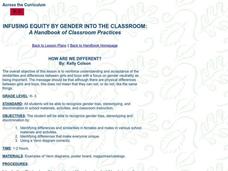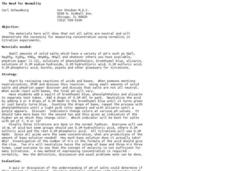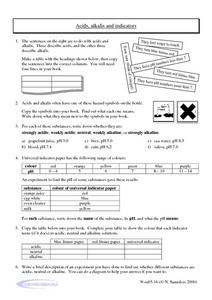Curated OER
Honors-Acid and Base Properties Homework
In this acid and base worksheet, students answer 8 questions about Arrhenius, Bronsted-Lowry, and Lewis bases. They determine Bronsted-Lowry conjugate acid-base pairs and they identify compounds and solutions as acids, bases or neutral.
Curated OER
Acid or Base? Toxie's On The Case!
In this chemistry worksheet, students read about the differences between substances that are acids and bases. They read about Litmus dye and the pH scale. They experiment with six household substance by testing them with litmus paper to...
Curated OER
Classifying Chemicals
In this acids and bases worksheet, high schoolers identify the strengths of acids and bases and indicate the concentration of hydronium and hydroxide ions. They determine if given chemical formulas are acids or bases,...
Curated OER
Writing Ionic Formulas
In this ions worksheet, students use a table of common ions to determine how to write the chemical formula, using subscripts, to make a neutral compound. This worksheet has 44 problems to solve.
Curated OER
How Are We Different?
Young scholars explain and accept the similarities and differences between girls and boys. They focus on gender neutrality and recognize gender bias, stereotyping, and discrimination in school materials, activities, and classroom...
Curated OER
Household Chemistry
Students use indicator paper to determine if substances are acidic, basic, or neutral. They test for Ph levels in them. They investigate the effect of oxygen on darkening fruit cut and exposed to the air. They observe vitamin C as an...
Curated OER
Acid Stomach
Students develop an understanding of how aspirin works and how understanding it's interaction with other chemicals in the body aided doctors in medical research. They complete a lab that compares the reaction of regular aspirin and...
Curated OER
Pre-Lab Questions-Acids and Bases
For this acids and bases worksheet, learners answer eight questions about acids and bases prior to doing a titration lab. They define both acids and bases and explain what a neutralization reaction is as well as a titration.
Curated OER
Losing and Gaining Electrons
In this electron worksheet, students read about how atoms lose and gain electrons and how they become ions. They are given a table with nine elements and they give the electron configuration, the number of electrons, the number of...
Curated OER
How to Balance Equations for Oxidation-Reduction Reactions
In this balancing oxidation-reduction reactions, students learn how to assign oxidation numbers to atoms in compounds, they learn how to write half reactions in order to balance oxidation-reduction reactions in acidic or neutral...
Curated OER
Titrations Worksheet
In this titrations activity, students answer 4 questions about titrations and solve for the pH of solutions and their concentrations. They determine the quantity of a base needed to neutralize an acid.
Curated OER
Color in Paintings
Students examine the color in paintings. In this visual arts lesson, students explore the 1821 painting by Jacques-Louis David and identify the colors in the art piece. Students write an original fairy tale and create an illustration...
Curated OER
Identification of Career Choices
Student examine gender in career choices. In this career lesson, students are given a list of careers and asked to put them in groups of male. female, and neutral. Students also look through magazines and cut out pictures of people in...
Curated OER
Floating Fishes: Boat Sinking Lab
Cut milk cartons in half to make boats and let investigators attempt to sink them. They add dividing walls and observe what happens if marbles are put into only one of the newly formed compartments. Vocabulary is provided: buoyant force,...
Curated OER
Buoyancy
In this buoyancy worksheet, students review Archimedes principle and the difference between positive, negative, and neutral buoyancy. This worksheet has 1 fill in the blank and 7 short answer questions.
Curated OER
stoichiometric (molarity, gases, mass)
In this chemistry worksheet, young scholars identify the volume that is required for complete precipitation. Then they identify what concentration of the base is in moles per liter. Students also name the formula weight of a hydroxide.
Teach Engineering
Cartesian Diver
Amaze your scholars with an activity that uses a Cartesian diver to demonstrate Pascal's Law, Archimedes' Principle, and the Ideal Gas Law. Groups then repeat the process and make their own diver move up and down in a bottle.
Royal Society of Chemistry
A Microscale Acid-Base Titration
Watch as acids and bases put smiles on their faces. Young chemists learn the concept of acid-base titration firsthand in a microscale experiment. Working groups collaborate, titrate, then use their data to determine the concentration of...
North Birmingham Academy
Color Theory
What better way to learn about colors than by coloring? Starting with the primary colors, young artists follow written prompts to shade in various rectangles and a color wheel to show complementary colors, tints and shades, and more.
Virginia Department of Education
Predicting Products and Writing Equations
A chemistry lesson presents 14 chemical reactions for scholars to observe, write the equation, and balance the equations. Additionally, it provides ways to extend the activity as it relates to catalysts.
Royal Society of Chemistry
Alkalis and Salts
Gamification is an educational sensation! Young scientists build their acid-base vocabulary skills through a series of puzzles focused on bases and the salts they form. The challenging activity comes complete with a printable version and...
American Chemical Society
Chemical Reactions and Color Change
Colors are more than just a pretty effect. Learners explore what color change means in terms of chemical properties and reactions. They create a pH solution using cabbage leaves and observe the changes when acids and bases are added.
Curated OER
The Need for Normality
High schoolers investigate the need for measuring concentrations in normality in titrations. In this titrations and normality lesson, students perform titrations and use different indicators to show they change colors at different pH...
Creative Chemistry
Acids, Alkalis and Indicators
In this pH instructional activity, learners describe acids and alkalis. They also determine whether substances are strongly acidic or alkaline. To determine the pH of given substances, learners use the color of universal indicator paper....























